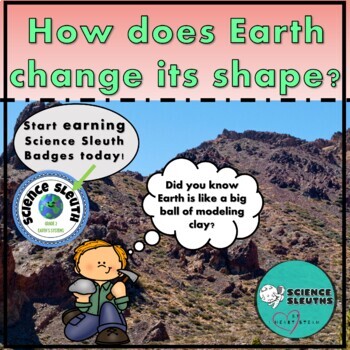Earth's Systems: Processes That Shape Earth NGSS STEM Grade 2 - Science Sleuths
- Google Drive™ folder

Also included in
- Second Grade NGSS Science curriculum for the entire year!Use Science Sleuths to teach NGSS Earth's Systems: Process that Shape Earth, Structure and Properties of Matter, and Ecosystems: Interdependent Relationships in Ecosystems for second grade. Includes a complete integrated unit with teacher staPrice $24.00Original Price $31.00Save $7.00
Description
Instruction for Earth's Changes NGSS Science Standards will never be the same again when your students become science sleuths and earn achievement badges!
BOOM! Science Sleuths has arrived!
Use Science Sleuths to teach NGSS Earth's Systems: Process that Shape Earth for second grade. Includes a complete integrated unit with teacher standard practices in the disciplinary core ideas, science and engineering practices, and crosscutting concepts. Other subject connections to ELA, Math, and Art are also included. BONUS: This is a Project-Based Learning Unit!
Students will read to learn with a grade level appropriate easy ready or story activity pages. Google version includes easy ready and activity pages, also. Did I mention there is an EASY NON-FICTION READER INCLUDED?!
This unit encourages students to think critically across subject matter. A Landform Poem with an enrichment project are also found within the unit. You will never need another resource for your science standards and STEM/STEAM learning! Your students will also get hands on experiments and games that engage for learning.
This unit is PDF formatted and made for Google formatted!
Teacher Guide Includes:
•General Instructions
•NGSS Standards and Lesson Correlations
•Phenomenon Instruction/ Questioning Tips/Badge Concept
•Other Subject Correlations
2 Badge Display Patterns
2 Badges
•Lesson Completion Badge
•Bonus Badge
Phenomenon Image
Story Pages:
Earth Investigation
How does Earth change its shape?
The Earth Around You
Earth's Water and Land
Time to be a Science Sleuth!
Changes to Earth
More Changes to Earth
Earth's Shape Game
Claim, Evidence, Reasoning
Erosion Investigation
Erosion Investigation Observation Book
Our Data Chart Example
Earth Sculptures
When Earth Changes Quickly
Preventing Changes
Earth's Landform Project & Interactive Notebook
Creating a Landscape
Landform Poem
Super Sleuth Challenge for Landform Poem
Extension Lesson: Colorado- An Interesting Landscape
Easy Reader
- 10 pages
Secret Picture Tiles
Secret Picture Tiles Picture Key for print and made for Google version
This unit includes 24+ Lessons that will excite and engage! See a video preview in the Science Sleuths Year Long Bundle!
Check out other Science Sleuths Units:Matter & Ecosystems !






